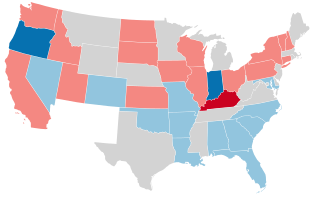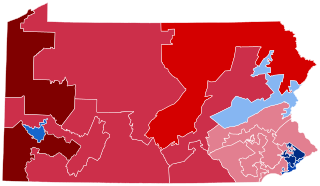
The 1982 United States Senate elections were held on November 2, 1982. They were elections for the United States Senate following Republican gains in 1980. The 33 Senate seats of Class 1 were up for election in 1982. A total of four seats changed hands between parties, with Democrats winning seats in New Jersey and New Mexico, and Republicans taking seats in Nevada and the seat of the lone independent, Senator Harry Byrd Jr., in Virginia. Democrats made a net gain of one seat bringing them to 46 seats, while Republicans stayed at 54 seats for a majority. However, the Democratic gain in New Jersey replaced a Republican that had been appointed earlier in the year.

The 1958 United States Senate elections were elections for the United States Senate which occurred in the middle of President Dwight D. Eisenhower's second term. Thirty-two seats of Class 1 were contested in regular elections, the new state of Alaska held its first Senate elections for its Class 2 and 3 seats, and two special elections were held to fill vacancies.

The 1922 United States Senate elections were elections that occurred in the middle of Republican President Warren G. Harding's term. The 32 seats of Class 1 were contested in regular elections, and special elections were held to fill vacancies. With the Republicans divided between conservative and progressive factions, the Democrats gained six net seats from the Republicans while the Farmer–Labor party gained one. The Republicans retained their Senate majority.

The 2006 Pennsylvania gubernatorial election was held on November 7, 2006 and included the races for the Governor of Pennsylvania and Lieutenant Governor of Pennsylvania. Incumbent Democratic Governor Ed Rendell successfully ran for re-election. Pennsylvania's first female lieutenant governor, Catherine Baker Knoll, was also running for re-election.

George Wharton Pepper was an American lawyer, law professor at the University of Pennsylvania Law School, Christian activist, and Republican politician from Philadelphia, Pennsylvania. He represented Pennsylvania in the United States Senate, and founded the law firm of Pepper Hamilton.

The 1908–09 United States Senate elections were held on various dates in various states. As these U.S. Senate elections were prior to the ratification of the Seventeenth Amendment in 1913, senators were primarily chosen by state legislatures. Senators were elected over a wide range of time throughout 1906 and 1907, and a seat may have been filled months late or remained vacant due to legislative deadlock. However, some states had already begun direct elections during this time. Oregon pioneered direct election and experimented with different measures over several years until it succeeded in 1907. Soon after, Nebraska followed suit and laid the foundation for other states to adopt measures reflecting the people's will. By 1912, as many as 29 states elected senators either as nominees of their party's primary or in conjunction with a general election.
The Pennsylvania Republican Party (PAGOP) is the state affiliate of the Republican Party in Pennsylvania. It is headquartered in Harrisburg. Its chair is Lawrence Tabas and is the second largest political party in the state behind the Pennsylvania Democratic Party.

The 1922 United States Senate election in Massachusetts was held on Tuesday, November 7. Incumbent Republican Senator Henry Cabot Lodge was re-elected to a fifth term in office over Democrat William A. Gaston.

The 1890–91 United States Senate elections were held on various dates in various states. As these U.S. Senate elections were prior to the ratification of the Seventeenth Amendment in 1913, senators were chosen by state legislatures. Senators were elected over a wide range of time throughout 1890 and 1891, and a seat may have been filled months late or remained vacant due to legislative deadlock. In these elections, terms were up for the senators in Class 3.

The 2012 United States Senate election in Pennsylvania was held on November 6, 2012, alongside a presidential election, other elections to the United States Senate in other states, as well as elections to the United States House of Representatives and various state and local elections. Incumbent Democratic U.S. Senator Bob Casey, Jr. ran for and won re-election to a second term, defeating Republican nominee Tom Smith, and Libertarian nominee Rayburn Smith.

The 1932 United States Senate election in Iowa took place on November 8, 1932. Incumbent Republican Senator Smith Brookhart, a controversial progressive figure within the conservative Iowa Republican Party, was defeated in the June Republican primary by Henry A. Field. Field was in turn defeated in the general election by Democrat Louis Murphy. Brookhart also entered the general election as the candidate of the Progressive Party but finished a distant third.

The 1926 United States Senate election in Pennsylvania was held on November 2, 1926. Incumbent Republican George W. Pepper, who was appointed following the death of Boies Penrose, was defeated for re-nomination by William Scott Vare. Vare won the election, defeating Democratic opponent William Bauchop Wilson. He was not permitted to assume office, however, until an investigation was conducted into possible election fraud and corruption. Vare was ultimately unseated in December 1929 by the Senate, following charges of corruption.

The 1922 United States Senate elections in Pennsylvania were held on November 7. Incumbent Republican U.S. Senator David A. Reed, who was appointed in August 1922 to fill the vacancy created by the death of William E. Crow, was elected both to complete the remainder of Crow's term, ending in March 1923, and to a full six-year term in his own right, beginning upon the expiration of Crow's term.

The 1930 Pennsylvania gubernatorial election occurred on November 4, 1930. Incumbent Republican governor John Stuchell Fisher was not a candidate for re-election. Republican candidate and former governor Gifford Pinchot defeated Democratic candidate John M. Hemphill to win a second, non-consecutive term as Governor of Pennsylvania.

The 2016 United States House of Representatives elections in Pennsylvania were held on November 8, 2016, to elect the 18 U.S. representatives from the Commonwealth of Pennsylvania, one from each of the state's 18 congressional districts. The elections coincided with the 2016 U.S. presidential election, as well as other elections to the House of Representatives, elections to the United States Senate, and various state and local elections. The primaries were held on April 26.

The 2020 United States House of Representatives elections in Pennsylvania were held on November 3, 2020, to elect the 18 U.S. representatives from the state of Pennsylvania, one from each of the state's 18 congressional districts. The state's primary election occurred on June 2, 2020. The elections coincided with the 2020 U.S. presidential election, as well as other elections to the House of Representatives, elections to the United States Senate and various state and local elections.

Elections were held in Illinois on Tuesday, November 3, 1936.

A general election was held in the U.S. state of Wyoming on Tuesday, November 3, 1914. All of the state's executive officers—the Governor, Secretary of State, Auditor, Treasurer, and Superintendent of Public Instruction—were up for election. Governor Joseph M. Carey declined to seek re-election to a second term, and Democratic State Senator John B. Kendrick was elected as his successor. Republicans, however, won all of the other statewide executive offices, including picking up the Superintendent's office.

An election for the United States Senate was held by the Pennsylvania General Assembly beginning on January 17, 1899, to fill the seat then held by Matthew Quay for a six-year term beginning March 4, 1899. Quay was a candidate for re-election, but he was damaged by a pending indictment for involvement in financial irregularities with state money; his trial took place during the three months that the legislature attempted to resolve the Senate deadlock, and he was acquitted the day it adjourned, having failed to elect a senator. Quay was appointed to the Senate seat by the governor, but the Senate refused to seat him on the grounds that the governor lacked the constitutional authority to make the selection, and the seat remained vacant until the next meeting of the legislature, in 1901, when Quay was elected.





















